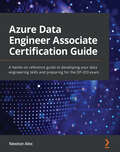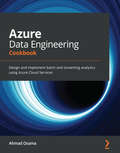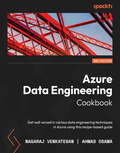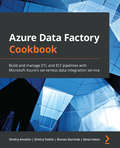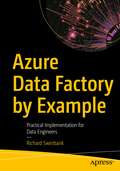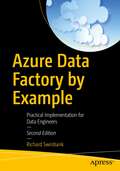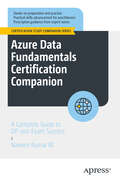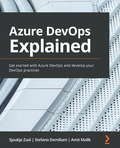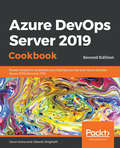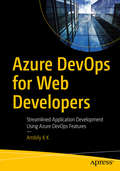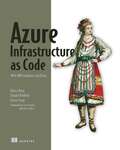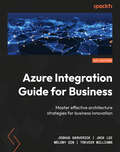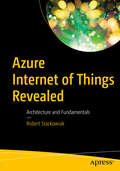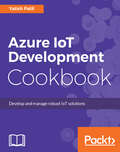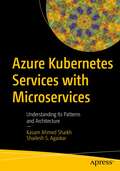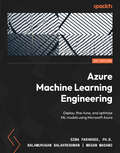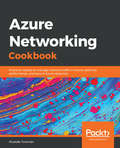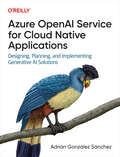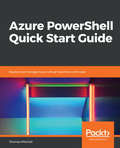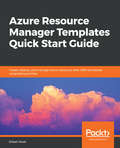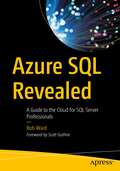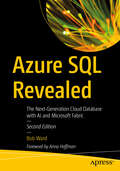- Table View
- List View
Azure Data Engineer Associate Certification Guide: A hands-on reference guide to developing your data engineering skills and preparing for the DP-203 exam
by Newton AlexBecome well-versed with data engineering concepts and exam objectives to achieve Azure Data Engineer Associate certificationKey FeaturesUnderstand and apply data engineering concepts to real-world problems and prepare for the DP-203 certification examExplore the various Azure services for building end-to-end data solutionsGain a solid understanding of building secure and sustainable data solutions using Azure servicesBook DescriptionAzure is one of the leading cloud providers in the world, providing numerous services for data hosting and data processing. Most of the companies today are either cloud-native or are migrating to the cloud much faster than ever. This has led to an explosion of data engineering jobs, with aspiring and experienced data engineers trying to outshine each other.Gaining the DP-203: Azure Data Engineer Associate certification is a sure-fire way of showing future employers that you have what it takes to become an Azure Data Engineer. This book will help you prepare for the DP-203 examination in a structured way, covering all the topics specified in the syllabus with detailed explanations and exam tips. The book starts by covering the fundamentals of Azure, and then takes the example of a hypothetical company and walks you through the various stages of building data engineering solutions. Throughout the chapters, you'll learn about the various Azure components involved in building the data systems and will explore them using a wide range of real-world use cases. Finally, you'll work on sample questions and answers to familiarize yourself with the pattern of the exam.By the end of this Azure book, you'll have gained the confidence you need to pass the DP-203 exam with ease and land your dream job in data engineering.What you will learnGain intermediate-level knowledge of Azure the data infrastructureDesign and implement data lake solutions with batch and stream pipelinesIdentify the partition strategies available in Azure storage technologiesImplement different table geometries in Azure Synapse AnalyticsUse the transformations available in T-SQL, Spark, and Azure Data FactoryUse Azure Databricks or Synapse Spark to process data using NotebooksDesign security using RBAC, ACL, encryption, data masking, and moreMonitor and optimize data pipelines with debugging tipsWho this book is forThis book is for data engineers who want to take the DP-203: Azure Data Engineer Associate exam and are looking to gain in-depth knowledge of the Azure cloud stack.The book will also help engineers and product managers who are new to Azure or interviewing with companies working on Azure technologies, to get hands-on experience of Azure data technologies. A basic understanding of cloud technologies, extract, transform, and load (ETL), and databases will help you get the most out of this book.
Azure Data Engineering Cookbook: Design and implement batch and streaming analytics using Azure Cloud Services
by Ahmad OsamaOver 90 recipes to help data scientists and AI engineers orchestrate modern ETL/ELT workflows and perform analytics using Azure services more easilyKey FeaturesDiscover how to work with different SQL and NoSQL data stores in Microsoft AzureCreate and execute real-time processing solutions using Azure Databricks, Azure Stream Analytics, and Azure Data ExplorerDesign and execute batch processing solutions using Azure Data FactoryBook DescriptionData engineering is a growing field that focuses on preparing data for analysis. This book uses various Azure services to implement and maintain infrastructure to extract data from multiple sources, and then transform and load it for data analysis. This book takes you through different techniques for performing big data engineering using Microsoft cloud services. It begins by showing you how Azure Blob storage can be used for storing large amounts of unstructured data and how to use it for orchestrating a data workflow. You'll then work with different Cosmos DB APIs and Azure SQL Database. Moving on, you'll discover how to provision an Azure Synapse database and find out how to ingest and analyze data in Azure Synapse. As you advance, you'll cover the design and implementation of batch processing solutions using Azure Data Factory, and understand how to manage, maintain, and secure Azure Data Factory pipelines. You'll also design and implement batch processing solutions using Azure Databricks and then manage and secure Azure Databricks clusters and jobs. In the concluding chapters, you'll learn how to process streaming data using Azure Stream Analytics and Data Explorer. By the end of this Azure book, you'll have gained the knowledge you need to be able to orchestrate batch and real-time ETL workflows in Microsoft Azure.What you will learnUse Azure Blob storage for storing large amounts of unstructured dataPerform CRUD operations on the Cosmos Table APIImplement elastic pools and business continuity with Azure SQL DatabaseIngest and analyze data using Azure Synapse AnalyticsDevelop Data Factory data flows to extract data from multiple sourcesManage, maintain, and secure Azure Data Factory pipelinesProcess streaming data using Azure Stream Analytics and Data ExplorerWho this book is forThis book is for database administrators, database developers, and extract, load, transform (ETL) developers looking to build expertise in Azure Data engineering using a recipe-based approach. Technical architects and database architects with experience in designing data or ETL applications either on-premise or on any other cloud vendor who want to learn Azure Data engineering concepts will also find this book useful. Prior knowledge of Azure fundamentals and data engineering concepts is needed.
Azure Data Engineering Cookbook: Get well versed in various data engineering techniques in Azure using this recipe-based guide, 2nd Edition
by Ahmad Osama Nagaraj VenkatesanNearly 80 recipes to help you collect and transform data from multiple sources into a single data source, making it way easier to perform analytics on the dataKey FeaturesBuild data pipelines from scratch and find solutions to common data engineering problemsLearn how to work with Azure Data Factory, Data Lake, Databricks, and Synapse AnalyticsMonitor and maintain your data engineering pipelines using Log Analytics, Azure Monitor, and Azure PurviewBook DescriptionThe famous quote 'Data is the new oil' seems more true every day as the key to most organizations' long-term success lies in extracting insights from raw data. One of the major challenges organizations face in leveraging value out of data is building performant data engineering pipelines for data visualization, ingestion, storage, and processing. This second edition of the immensely successful book by Ahmad Osama brings to you several recent enhancements in Azure data engineering and shares approximately 80 useful recipes covering common scenarios in building data engineering pipelines in Microsoft Azure.You'll explore recipes from Azure Synapse Analytics workspaces Gen 2 and get to grips with Synapse Spark pools, SQL Serverless pools, Synapse integration pipelines, and Synapse data flows. You'll also understand Synapse SQL Pool optimization techniques in this second edition. Besides Synapse enhancements, you'll discover helpful tips on managing Azure SQL Database and learn about security, high availability, and performance monitoring. Finally, the book takes you through overall data engineering pipeline management, focusing on monitoring using Log Analytics and tracking data lineage using Azure Purview.By the end of this book, you'll be able to build superior data engineering pipelines along with having an invaluable go-to guide.What you will learnProcess data using Azure Databricks and Azure Synapse AnalyticsPerform data transformation using Azure Synapse data flowsPerform common administrative tasks in Azure SQL DatabaseBuild effective Synapse SQL pools which can be consumed by Power BIMonitor Synapse SQL and Spark pools using Log AnalyticsTrack data lineage using Microsoft Purview integration with pipelinesWho this book is forThis book is for data engineers, data architects, database administrators, and data professionals who want to get well versed with the Azure data services for building data pipelines. Basic understanding of cloud and data engineering concepts will help in getting the most out of this book.
Azure Data Factory Cookbook
by Dmitry AnoshinThis book is for ETL developers, data warehouse and ETL architects, software professionals, and anyone who wants to learn about the common and not-so-common challenges faced while developing traditional and hybrid ETL solutions using Microsoft's Azure Data Factory. You’ll also find this book useful if you are looking for recipes to improve or enhance your existing ETL pipelines. Basic knowledge of data warehousing is expected.
Azure Data Factory Cookbook: Build ETL, Hybrid ETL, and ELT pipelines using ADF, Synapse Analytics, Fabric and Databricks
by Dmitry Foshin Tonya Chernyshova Dmitry Anoshin Xenia IretonData Engineers guide to solve real-world problems encountered while building and transforming data pipelines using Azure's data integration toolKey FeaturesSolve real-world data problems and create data-driven workflows with ease using Azure Data FactoryBuild an ADF pipeline that operates on pre-built ML model and Azure AIGet up and running with Fabric Data Explorer and extend ADF with Logic Apps and Azure functionsBook DescriptionThis new edition of the Azure Data Factory book, fully updated to reflect ADS V2, will help you get up and running by showing you how to create and execute your first job in ADF. There are updated and new recipes throughout the book based on developments happening in Azure Synapse, Deployment with Azure DevOps, and Azure Purview. The current edition also runs you through Fabric Data Factory, Data Explorer, and some industry-grade best practices with specific chapters on each. You’ll learn how to branch and chain activities, create custom activities, and schedule pipelines, as well as discover the benefits of cloud data warehousing, Azure Synapse Analytics, and Azure Data Lake Gen2 Storage. With practical recipes, you’ll learn how to actively engage with analytical tools from Azure Data Services and leverage your on-premises infrastructure with cloud-native tools to get relevant business insights. You'll familiarize yourself with the common errors that you may encounter while working with ADF and find out the solutions to them. You’ll also understand error messages and resolve problems in connectors and data flows with the debugging capabilities of ADF. By the end of this book, you’ll be able to use ADF with its latest advancements as the main ETL and orchestration tool for your data warehouse projects.What you will learnBuild and Manage data pipelines with ease using the latest version of ADFConfigure, load data, and operate data flows with Azure SynapseGet up and running with Fabric Data FactoryWorking with Azure Data Factory and Azure PurviewCreate big data pipelines using Databricks and Delta tablesIntegrate ADF with commonly used Azure services such as Azure ML, Azure Logic Apps, and Azure FunctionsLearn industry-grade best practices for using Azure Data FactoryWho this book is forThis book is for ETL developers, data warehouse and ETL architects, software professionals, and anyone else who wants to learn about the common and not-so-common challenges faced while developing traditional and hybrid ETL solutions using Microsoft's Azure Data Factory. You’ll also find this book useful if you are looking for recipes to improve or enhance your existing ETL pipelines. Basic knowledge of data warehousing is a prerequisite.
Azure Data Factory by Example: Practical Implementation for Data Engineers
by Richard SwinbankData engineers who need to hit the ground running will use this book to build skills in Azure Data Factory v2 (ADF). The tutorial-first approach to ADF taken in this book gets you working from the first chapter, explaining key ideas naturally as you encounter them. From creating your first data factory to building complex, metadata-driven nested pipelines, the book guides you through essential concepts in Microsoft’s cloud-based ETL/ELT platform. It introduces components indispensable for the movement and transformation of data in the cloud. Then it demonstrates the tools necessary to orchestrate, monitor, and manage those components.The hands-on introduction to ADF found in this book is equally well-suited to data engineers embracing their first ETL/ELT toolset as it is to seasoned veterans of Microsoft’s SQL Server Integration Services (SSIS). The example-driven approach leads you through ADF pipeline construction from the ground up, introducing important ideas and making learning natural and engaging. SSIS users will find concepts with familiar parallels, while ADF-first readers will quickly master those concepts through the book’s steady building up of knowledge in successive chapters. Summaries of key concepts at the end of each chapter provide a ready reference that you can return to again and again.What You Will LearnCreate pipelines, activities, datasets, and linked servicesBuild reusable components using variables, parameters, and expressionsMove data into and around Azure services automaticallyTransform data natively using ADF data flows and Power Query data wranglingMaster flow-of-control and triggers for tightly orchestrated pipeline executionPublish and monitor pipelines easily and with confidenceWho This Book Is ForData engineers and ETL developers taking their first steps in Azure Data Factory, SQL Server Integration Services users making the transition toward doing ETL in Microsoft’s Azure cloud, and SQL Server database administrators involved in data warehousing and ETL operations
Azure Data Factory by Example: Practical Implementation for Data Engineers
by Richard SwinbankData engineers who need to hit the ground running will use this book to build skills in Azure Data Factory v2 (ADF). The tutorial-first approach to ADF taken in this book gets you working from the first chapter, explaining key ideas naturally as you encounter them. From creating your first data factory to building complex, metadata-driven nested pipelines, the book guides you through essential concepts in Microsoft’s cloud-based ETL/ELT platform. It introduces components indispensable for the movement and transformation of data in the cloud. Then it demonstrates the tools necessary to orchestrate, monitor, and manage those components.This edition, updated for 2024, includes the latest developments to the Azure Data Factory service:Enhancements to existing pipeline activities such as Execute Pipeline, along with the introduction of new activities such as Script, and activities designed specifically to interact with Azure Synapse Analytics.Improvements to flow control provided by activity deactivation and the Fail activity.The introduction of reusable data flow components such as user-defined functions and flowlets.Extensions to integration runtime capabilities including Managed VNet support.The ability to trigger pipelines in response to custom events.Tools for implementing boilerplate processes such as change data capture and metadata-driven data copying.What You Will LearnCreate pipelines, activities, datasets, and linked servicesBuild reusable components using variables, parameters, and expressionsMove data into and around Azure services automaticallyTransform data natively using ADF data flows and Power Query data wranglingMaster flow-of-control and triggers for tightly orchestrated pipeline executionPublish and monitor pipelines easily and with confidenceWho This Book Is ForData engineers and ETL developers taking their first steps in Azure Data Factory, SQL Server Integration Services users making the transition toward doing ETL in Microsoft’s Azure cloud, and SQL Server database administrators involved in data warehousing and ETL operations
Azure Data Fundamentals Certification Companion: A Complete Guide to DP-900 Exam Success (Certification Study Companion Series)
by Naveen Kumar MTransform your understanding of data and take your career to the next level. This book not only helps you prepare for an exam, but also helps you build a foundation for a future in the ever-expanding world of data and cloud computing. The book starts with an exam overview to take you through the structure and format of the exam. You will go through the foundational knowledge in core data concepts, explaining how structured, semi-structured, and unstructured data are stored and managed, as well as the roles of key data professionals. The journey continues with relational data on Azure, covering database normalization, SQL fundamentals, and Azure&’s relational database offerings, including SQL Server, MySQL, and PostgreSQL. The book then delves into non-relational data, exploring Azure Blob Storage, Table Storage, and Cosmos DB, providing insights into their use cases and applications. The book also covers analytics workloads, focusing on large-scale data processing, real-time analytics, and data visualization using Power BI. The book concludes with an exam preparation guide, offering structured study plans, practice questions, and a full-length mock test to help you gain confidence and excel on the DP-900 certification exam. What You Will Learn Understand structured, semi-structured, and unstructured data, and the difference between transactional and analytical workloads Understand relational databases and Azure services such as Azure SQL Database and Managed Instance Explore storage solutions such as Azure Blob Storage and Azure Cosmos DB for handling diverse data types Discover tools such as Azure Synapse Analytics, Azure Databricks, and Power BI for analyzing and visualizing data Who This Book Is For Azure data engineers, data analysts, and database administrators
Azure Data Scientist Associate Certification Guide: A hands-on guide to machine learning in Azure and passing the Microsoft Certified DP-100 exam
by Andreas Botsikas Michael HlobilDevelop the skills you need to run machine learning workloads in Azure and pass the DP-100 exam with easeKey FeaturesCreate end-to-end machine learning training pipelines, with or without codeTrack experiment progress using the cloud-based MLflow-compatible process of Azure ML servicesOperationalize your machine learning models by creating batch and real-time endpointsBook DescriptionThe Azure Data Scientist Associate Certification Guide helps you acquire practical knowledge for machine learning experimentation on Azure. It covers everything you need to pass the DP-100 exam and become a certified Azure Data Scientist Associate.Starting with an introduction to data science, you'll learn the terminology that will be used throughout the book and then move on to the Azure Machine Learning (Azure ML) workspace. You'll discover the studio interface and manage various components, such as data stores and compute clusters.Next, the book focuses on no-code and low-code experimentation, and shows you how to use the Automated ML wizard to locate and deploy optimal models for your dataset. You'll also learn how to run end-to-end data science experiments using the designer provided in Azure ML Studio.You'll then explore the Azure ML Software Development Kit (SDK) for Python and advance to creating experiments and publishing models using code. The book also guides you in optimizing your model's hyperparameters using Hyperdrive before demonstrating how to use responsible AI tools to interpret and debug your models. Once you have a trained model, you'll learn to operationalize it for batch or real-time inferences and monitor it in production.By the end of this Azure certification study guide, you'll have gained the knowledge and the practical skills required to pass the DP-100 exam.What you will learnCreate a working environment for data science workloads on AzureRun data experiments using Azure Machine Learning servicesCreate training and inference pipelines using the designer or codeDiscover the best model for your dataset using Automated MLUse hyperparameter tuning to optimize trained modelsDeploy, use, and monitor models in productionInterpret the predictions of a trained modelWho this book is forThis book is for developers who want to infuse their applications with AI capabilities and data scientists looking to scale their machine learning experiments in the Azure cloud. Basic knowledge of Python is needed to follow the code samples used in the book. Some experience in training machine learning models in Python using common frameworks like scikit-learn will help you understand the content more easily.
Azure DevOps Explained: Get started with Azure DevOps and develop your DevOps practices
by Amit Malik Stefano Demiliani Sjoukje ZaalImplement real-world DevOps and cloud deployment scenarios using Azure Repos, Azure Pipelines, and other Azure DevOps tools Key Features • Improve your application development life cycle with Azure DevOps in a step-by-step manner • Apply continuous integration and continuous deployment to reduce application downtime • Work with real-world CI/CD scenarios curated by a team of renowned Microsoft MVPs and MCTs Book Description Developing applications for the cloud involves changing development methodologies and procedures. Continuous integration and continuous deployment (CI/CD) processes are a must today, but are often difficult to implement and adopt. Azure DevOps is a Microsoft Azure cloud service that enhances your application development life cycle and enables DevOps capabilities. Starting with a comprehensive product overview, this book helps you to understand Azure DevOps and apply DevOps techniques to your development projects. You'll find out how to adopt DevOps techniques for your development processes by using built-in Azure DevOps tools. Throughout the course of this book, you'll also discover how to manage a project with the help of project management techniques such as Agile and Scrum, and then progress toward development aspects such as source code management, build pipelines, code testing and artifacts, release pipelines, and GitHub integration. As you learn how to implement DevOps practices, this book will also provide you with real-world examples and scenarios of DevOps adoption. By the end of this DevOps book, you will have learned how to adopt and implement Azure DevOps features in your real-world development processes. What you will learn • Get to grips with Azure DevOps • Find out about project management with Azure Boards • Understand source code management with Azure Repos • Build and release pipelines • Run quality tests in build pipelines • Use artifacts and integrate Azure DevOps in the GitHub flow • Discover real-world CI/CD scenarios with Azure DevOps Who this book is for This book is for developers, solutions architects, and DevOps engineers interested in getting started with cloud DevOps practices on Azure. Prior understanding of Azure architecture and services is necessary. Some knowledge of DevOps principles and techniques will be useful.
Azure DevOps Server 2019 Cookbook,: Proven recipes to accelerate your DevOps journey with Azure DevOps Server 2019 (formerly TFS), 2nd Edition
by Tarun Arora Utkarsh ShigihalliOver 70 recipes to effectively apply DevOps best practices and implement Agile, Git, CI-CD & Test automation using Azure DevOps Server (TFS) 2019Key FeaturesLearn improving code quality using pull requests, branch policies, githooks and git branching designAccelerate the deployment of high quality software by automating build and releases using CI-CD Pipelines.Learn tried and tested techniques to automate database deployments, App Service & Function Deployments in Azure.Book DescriptionAzure DevOps Server, previously known as Team Foundation Server (TFS), is a comprehensive on-premise DevOps toolset with a rich ecosystem of open source plugins. This book is your one stop guide to learn how to effectively use all of these Azure DevOps services to go from zero to DevOps. You will start by building high-quality scalable software targeting .NET, .NET core or Node.js applications. You will learn techniques that will help you to set up end-to-end traceability of your code changes from design through to release. Whether you are deploying software on-premise or in the cloud in App Service, Functions, or Azure VMs, this book will help you learn release management techniques to reduce release failures. Next, you will be able to secure application configuration by using Azure KeyVault. You will also learn how to create and release extensions to the Azure DevOps marketplace and reach million developer ecosystem for feedback. The working extension samples will allow you to iterate changes in your extensions easily and release updates to the marketplace quickly. By the end of this book, techniques provided in the book will help you break down the invisible silos between your software development teams. This will transform you from being a good software development team to an elite modern cross functional software development team.What you will learnSet up a team project for an Agile delivery team, importing requirements from ExcelPlan,track, and monitor progress using self updating boards, Sprint and Kanban boardsUnlock the features of Git by using branch policies, Git pull requests, forks, and Git hooksBuild and release .NET core, SQL and Node.js applications using Azure PipelineAutomate testing by integrating Microsoft and open source testing frameworksExtend Azure DevOps Server to a million developer ecosystemWho this book is forThis book is for anyone looking to succeed with DevOps. The techniques in this book apply to all roles of the software development lifecycle including developers, testers, architects, configuration analysts, site reliability engineers and release managers. If you are a new user you’ll learn how to get started; if you are an experienced user you’ll learn how to launch your project into a modern and mature DevOps enabled software development team.
Azure DevOps for Web Developers: Streamlined Application Development Using Azure DevOps Features
by Ambily K KExplore the architecture, product offerings, and the various stages of implementation processes in Azure DevOps. The book starts with the basic concepts of DevOps and moves on to discuss project management in Azure DevOps. Next, you will learn requirement management and version control in DevOps. Along the way, you will go through test management followed by continuous integration and build automation with more details on code quality and security implementations. Moving forward, you will learn release pipeline and infrastructure as code implementation including ARM-based environment provisioning and execution. Finally, you’ll cover DevOps architecture blueprints used for deploying your web applications to different platforms . After reading this book, you will be able to understand each stage of Azure DevOps and master its implementation. What You Will Learn Understand the various concepts of Azure DevOps Apply DevOps concepts in a variety of application contexts including web applications, containers, and database Understand the implementation of end-to-end DevOps in Azure Work with the different DevOps design patterns and architectures in Azure Who Is This Book For:Developers and architects working with Azure.
Azure Infrastructure as Code: With ARM templates and Bicep
by Henry Been Erwin Staal Eduard KeiholzMaster ARM templates, Bicep, and other Azure Infrastructure-as-Code tools, techniques, and practices to build infrastructure on the Azure cloud.In Azure Infrastructure as Code you will learn how to: Create reusable infrastructure templates using advanced features of the ARM (Azure Resource Manager) syntax Write templates with the Azure Bicep domain-specific language (DSL) Test ARM and Bicep templates Deploy templates using deployment pipelines Guarantee repeated outcomes when you reuse templates to replicate infrastructure Share templates between teams Provision templates to provide standards and Azure Policy to enforce them Orchestrate complex deployments using Azure DevOps and GitHub Actions Pre-provision environments for other teams with deployment stacks Azure Infrastructure as Code teaches you to use Azure&’s native infrastructure as code (IaC) tools, like ARM and Bicep, to build, manage, and scale infrastructure with just a few lines of code. You&’ll discover ARM templates, deployment stacks, and the powerful new language Bicep. See how easy they make it to create new environments, safely make infrastructure changes, govern your resources using Azure Policy, and prevent configuration drift. Loaded with in-depth coverage of syntax and lots of illustrative examples, this hands-on guide is a must-read for anyone looking to expand their knowledge of provisioning. About the technology Automating tasks like provisioning servers, operating systems, and storage, saves time and radically increases consistency. The Infrastructure as Code (IaC) approach brings the tools and practices of application deployment, such as Github Actions, automated testing, and pipeline-driven deployments, to infrastructure components. With Azure&’s native IaC tools, you can create whole new infrastructures with just a few lines of code using declarative specifications and an intuitive domain-specific language. About the book Azure Infrastructure as Code shows you how to manage and automate your infrastructure using Azure&’s IaC tools. In this practical guide, you&’ll discover how to set up Azure Resource Manager (ARM) templates and to script infrastructure creation using the Bicep DSL. You&’ll also explore advanced topics such as testing, reusing templates, and defining policies as code. You&’ll even build a complete CI/CD pipeline that can orchestrate a complex infrastructure deployment across multiple regions. What's inside Create reusable infrastructure templates Write templates with the Azure Bicep domain-specific language Deploy templates using deployment pipelines Share templates between teams About the reader For operations, infrastructure, or software engineers with some Azure experience. About the author Henry Been is a freelance DevOps and Azure architect and consultant. Erwin Staal is an Azure architect and DevOps consultant. Eduard Keilholz is a cloud solution architect. Table of Contents PART 1 INTRODUCTION 1 Infrastructure as Code 2 Writing your first ARM template PART 2 TAKING IT UP A NOTCH 3 Writing ARM templates 4 Deploying ARM templates 5 Writing advanced ARM templates 6 Simplifying ARM templates using the Bicep DSL 7 Complex deployments using Azure DevOps 8 Complex deployments using GitHub Actions 9 Testing ARM templates PART 3 ADVANCED TOPICS 10 Template specs and Bicep registries: Building a repository of templates 11 Using deployment stacks for grouping resources 12 Governing your subscriptions using Azure Policy 13 Case studies
Azure Integration Guide for Business: Master effective architecture strategies for business innovation
by Joshua Garverick Jack Lee Mélony Qin Trevoir WilliamsLeverage the cloud to optimize costs, improve security, and seamlessly scale your business operationsKey FeaturesAchieve your operational goals with Azure infrastructureOptimize costs with serverless event-driven solutions through Azure cloud patternsBoost productivity with Azure architecture’s flexibility and scalabilityPurchase of the print or Kindle book includes a free PDF eBookBook DescriptionAzure Integration Guide for Business is essential for decision makers planning to transform their business with Microsoft Azure. The Microsoft Azure cloud platform can improve the availability, scalability, and cost-efficiency of any business. The guidance in this book will help decision makers gain valuable insights into proactively managing their applications and infrastructure. You'll learn to apply best practices in Azure Virtual Network and Azure Storage design, ensuring an efficient and secure cloud infrastructure. You'll also discover how to automate Azure through Infrastructure as Code (IaC) and leverage various Azure services to support OLTP applications. Next, you’ll explore how to implement Azure offerings for event-driven architectural solutions and serverless applications. Additionally, you’ll gain in-depth knowledge on how to develop an automated, secure, and scalable solutions. Core elements of the Azure ecosystem will be discussed in the final chapters of the book, such as big data solutions, cost governance, and best practices to help you optimize your business. By the end of this book, you’ll understand what a well-architected Azure solution looks like and how to lead your organization toward a tailored Azure solution that meets your business needs.What you will learnOptimize the performance and costs with AzureSelect an effective, scalable, and flexible solution that aligns with your needsHarness the power of containers to drive your application development and deploymentCreate big data solutions with the best Azure tools, platforms, and resourcesExplore the benefits of automation for enhanced productivityImprove the availability and effectiveness of monitoring with AzureWho this book is forThis book is for business decision makers looking to benefit from the flexibility, scalability, and optimized costs offered by Microsoft Azure to scale their businesses. Basic knowledge of Azure is recommended to get the most out of this book.
Azure Internet of Things Revealed: Architecture and Fundamentals
by Robert StackowiakDesign, build, and justify an optimal Microsoft IoT footprint to meet your project needs. This book describes common Internet of Things components and architecture and then focuses on Microsoft’s Azure components relevant in deploying these solutions.Microsoft-specific topics addressed include: deploying edge devices and pushing intelligence to the edge; connecting IoT devices to Azure and landing data there, applying Azure Machine Learning, analytics, and Cognitive Services; roles for Microsoft solution accelerators and managed solutions; and integration of the Azure footprint with legacy infrastructure.The book concludes with a discussion of best practices in defining and developing solutions and creating a plan for success.What You Will LearnDesign the right IoT architecture to deliver solutions for a variety of project needsConnect IoT devices to Azure for data collection and delivery of servicesUse Azure Machine Learning and Cognitive Services to deliver intelligence in cloud-based solutions and at the edgeUnderstand the benefits and tradeoffs of Microsoft's solution accelerators and managed solutionsInvestigate new use cases that are described and apply best practices in deployment strategiesIntegrate cutting-edge Azure deployments with existing legacy data sourcesWho This Book Is ForDevelopers and architects new to IoT projects or new to Microsoft Azure IoT components as well as readers interested in best practices used in architecting IoT solutions that utilize the Azure platform
Azure IoT Development Cookbook
by Yatish PatilOver 50 recipes to drive IoT innovation with Microsoft Azure About This Book • Build secure and scalable IoT solutions with Azure IoT platform • Learn techniques to build end to end IoT solutions leveraging the Azure IoT platform • Filled with practical recipes to help you increase connectivity and automation across IoT devices Who This Book Is For If you are an application developer and want to build robust and secure IoT solution for your organization using Azure IoT, then this book is for you. What You Will Learn • Build IoT Solutions using Azure IoT & Services • Learn device configuration and communication protocols • Understand IoT Suite and Pre-configured solutions • Manage Secure Device communications • Understand Device management, alerts • Introduction with IoT Analytics, reference IoT Architectures • Reference Architectures from Industry • Pre-Configured IoT Suite solutions In Detail Microsoft's end-to-end IoT platform is the most complete IoT offering, empowering enterprises to build and realize value from IoT solutions efficiently. It is important to develop robust and reliable solutions for your organization to leverage IoT services. This book focuses on how to start building custom solutions using the IoT hub or the preconfigured solution of Azure IoT suite. As a developer, you will be taught how to connect multiple devices to the Azure IoT hub, develop, manage the IoT hub service and integrate the hub with cloud. We will be covering REST APIs along with HTTP, MQTT and AMQP protocols. It also helps you learn Pre-Configured IoT Suite solution. Moving ahead we will be covering topics like:-Process device-to-cloud messages and cloud-to-device messages using .Net-Direct methods and device management-Query Language, Azure IoT SDK for .Net-Creating and managing, Securing IoT hub, IoT Suite and many more. We will be using windows 10 IoT core, Visual Studio, universal Windows platform. At the end, we will take you through IoT analytics and provide a demo of connecting real device with Azure IoT. Style and approach A set of exciting recipes of using Microsoft Azure IoT more effectively.
Azure Kubernetes Services with Microservices: Understanding Its Patterns and Architecture
by Kasam Ahmed Shaikh Shailesh S. AgaskarDesign and implement scalable microservices using Azure Kubernetes Services (AKS) and other Azure Services. This book will help you understand why and when to choose microservices as a solution for modernization and how to use Azure DevOps to implement CI/CD for deploying microservices. The book starts with an introduction to the evolution to microservices and AKS along with its components. You will learn design patterns to implement microservices on AKS and understand Kubernetes as a container orchestration platform. You will go through the common errors faced in AKS-based applications and ways to handle them. You will learn error handling tips and tricks and how to design for business continuity and disaster recovery. The book discusses things you should know related to security and monitoring when working with AKS-based applications. The book presents a practical approach to set up processes for CI/CD, such as building Build and release pipelines for AKS deployment using Azure DevOps. After reading this book, you will understand design considerations for designing scalable microservices and know how to implement the design through AKS. What You Will LearnKnow design patterns for microservices and how to handle failure scenariosBe aware of architecture and design considerationsUnderstand container and Kubernetes architecture componentsUnderstand security and monitoring aspectsTake a practical approach to continuous integration and continuous deliveryWho This Book Is ForIT professionals associated with cloud computing, especially with Microsoft Azure
Azure Machine Learning Engineering: Deploy, fine-tune, and optimize ML models using Microsoft Azure
by Sina Fakhraee Balamurugan Balakreshnan Megan MasanzFully build and productionize end-to-end machine learning solutions using Azure Machine Learning ServiceKey FeaturesAutomate complete machine learning solutions using Microsoft AzureUnderstand how to productionize machine learning modelsGet to grips with monitoring, MLOps, deep learning, distributed training, and reinforcement learningBook DescriptionData scientists working on productionizing machine learning (ML) workloads face a breadth of challenges at every step owing to the countless factors involved in getting ML models deployed and running. This book offers solutions to common issues, detailed explanations of essential concepts, and step-by-step instructions to productionize ML workloads using the Azure Machine Learning service. You'll see how data scientists and ML engineers working with Microsoft Azure can train and deploy ML models at scale by putting their knowledge to work with this practical guide.Throughout the book, you'll learn how to train, register, and productionize ML models by making use of the power of the Azure Machine Learning service. You'll get to grips with scoring models in real time and batch, explaining models to earn business trust, mitigating model bias, and developing solutions using an MLOps framework.By the end of this Azure Machine Learning book, you'll be ready to build and deploy end-to-end ML solutions into a production system using the Azure Machine Learning service for real-time scenarios.What you will learnTrain ML models in the Azure Machine Learning serviceBuild end-to-end ML pipelinesHost ML models on real-time scoring endpointsMitigate bias in ML modelsGet the hang of using an MLOps framework to productionize modelsSimplify ML model explainability using the Azure Machine Learning service and Azure InterpretWho this book is forMachine learning engineers and data scientists who want to move to ML engineering roles will find this AMLS book useful. Familiarity with the Azure ecosystem will assist with understanding the concepts covered.
Azure Networking Cookbook: Practical recipes to manage network traffic in Azure, optimize performance, and secure Azure resources
by Mustafa ToromanThis book is targeted towards cloud architects, cloud solution providers, or any stakeholders dealing with networking on the Azure cloud. Some prior understanding of Microsoft Azure will be a plus point.
Azure OpenAI Service for Cloud Native Applications: Designing, Planning, and Implementing Generative AI Solutions
by Adrián González SánchezGet the details, examples, and best practices you need to build generative AI applications, services, and solutions using the power of Azure OpenAI Service. With this comprehensive guide, Microsoft AI specialist Adrián González Sánchez examines the integration and utilization of Azure OpenAI Service—using powerful generative AI models such as GPT-4 and GPT-4o—within the Microsoft Azure cloud computing platform.To guide you through the technical details of using Azure OpenAI Service, this book shows you how to set up the necessary Azure resources, prepare end-to-end architectures, work with APIs, manage costs and usage, handle data privacy and security, and optimize performance. You'll learn various use cases where Azure OpenAI Service models can be applied, and get valuable insights from some of the most relevant AI and cloud experts.Ideal for software and cloud developers, product managers, architects, and engineers, as well as cloud-enabled data scientists, this book will help you:Learn how to implement cloud native applications with Azure OpenAI ServiceDeploy, customize, and integrate Azure OpenAI Service with your applicationsCustomize large language models and orchestrate knowledge with company-owned dataUse advanced roadmaps to plan your generative AI projectEstimate cost and plan generative AI implementations for adopter companies
Azure PowerShell Quick Start Guide: Deploy and manage Azure virtual machines with ease
by Thomas MitchellLeverage PowerShell to perform many day-to-day tasks in Microsoft Azure Key Features Deploy and manage Azure virtual machines with PowerShell commands. Get to grips with core concept of Azure PowerShell such as working with images and disks, custom script extension, high availability and more. Leverage hands-on projects to successfully apply what you learned through the course of this book. Book Description As an IT professional, it is important to keep up with cloud technologies and learn to manage those technologies. PowerShell is a critical tool that must be learned in order to effectively and more easily manage many Azure resources. This book is designed to teach you to leverage PowerShell to enable you to perform many day-to-day tasks in Microsoft Azure. Taking you through the basic tasks of installing Azure PowerShell and connecting to Azure, you will learn to properly connect to an Azure tenant with PowerShell. Next, you will dive into tasks such as deploying virtual machines with PowerShell, resizing them, and managing their power states with PowerShell. Then, you will learn how to complete more complex Azure tasks with PowerShell, such as deploying virtual machines from custom images, creating images from existing virtual machines, and creating and managing of data disks. Later, you will learn how to snapshot virtual machines, how to encrypt virtual machines, and how to leverage load balancers to ensure high availability with PowerShell. By the end of this book, you will have developed dozens of PowerShell skills that are invaluable in the deployment and management of Azure virtual machines. What you will learn Manage virtual machines with PowerShell Resize a virtual machine with PowerShell Create OS disk snapshots via PowerShell Deploy new virtual machines from snapshots via PowerShell Provision and attach data disks to a virtual machine via PowerShell Load balance virtual machines with PowerShell Manage virtual machines with custom script extensions Who this book is for This book is intended for IT professionals who are responsible for managing Azure virtual machines. No prior PowerShell or Azure experience is needed.
Azure Resource Manager Templates Quick Start Guide: Create, deploy, and manage Azure resources with ARM templates using best practices
by Ritesh ModiCompose and decompose ARM templates and use advanced concepts like looping, conditions, dependencies, PowerShell and Desired State Configuration.Key FeaturesDesign, implement, and unit test ARM templatesDevelop and deploy ARM templates following security best practicesBook DescriptionAzure Resource Manager (ARM) templates are declarations of Azure resources in the JSON format to provision and maintain them using infrastructure as code. This book gives practical solutions and examples for provisioning and managing various Azure services using ARM templates.The book starts with an understanding of infrastructure as code, a refresher on JSON, and then moves on to explain the fundamental concepts of ARM templates. Important concepts like iteration, conditional evaluation, security, usage of expressions, and functions will be covered in detail. You will use linked and nested templates to create modular ARM templates. You will see how to create multiple instances of the same resources, how to nest and link templates, and how to establish dependencies between them. You will also learn about implementing design patterns, secure template design, the unit testing of ARM templates, and adopting best practices.By the end of this book, you will understand the entire life cycle of ARM templates and their testing, and be able to author them for complex deployments.What you will learnUnderstand the foundations of ARM templates including nested and linked templatesDesign, create, and unit test ARM templates using best practicesLearn about conditional deployments, looping, Custom Script Extensions using PowerShell, Bash, and DSCImplement design patterns related to ARM templatesRun post-deployment PowerShell and Desired State Configuration scriptsCreate solutions and deploy them on Azure using ARM templatesWho this book is forThis books is for developers, DevOps engineers, and architects who have experience in Azure.
Azure SQL Hyperscale Revealed: High-performance Scalable Solutions for Critical Data Workloads
by Zoran Barać Daniel Scott-RaynsfordTake a deep dive into the Azure SQL Database Hyperscale Service Tier and discover a new form of cloud architecture from Microsoft that supports massive databases. The new horizontally scalable architecture, formerly code-named Socrates, allows you to decouple compute nodes from storage layers. This radically different approach dramatically increases the scalability of the service. This book shows you how to leverage Hyperscale to provide next-level scalability, high throughput, and fast performance from large databases in your environment.The book begins by showing how Hyperscale helps you eliminate many of the problems of traditional high-availability and disaster recovery architecture. You’ll learn how Hyperscale overcomes storage capacity limitations and issues with scale-up times and costs. With Hyperscale, your costs do not increase linearly with database size and you can manage more data than ever at a lower cost.The book teaches you how to deploy, configure, and monitor an Azure SQL Hyperscale database in a production environment. The book also covers migrating your current workloads from traditional architecture to Azure SQL Hyperscale. What You Will LearnUnderstand the advantages of Hyperscale over traditional architectureDeploy a Hyperscale database on the Azure cloud (interactively and with code)Configure the advanced features of the Hyperscale database tierMonitor and scale database performance to suit your needsBack up and restore your Azure SQL Hyperscale databasesImplement disaster recovery and failover capabilityCompare performance of Hyperscale vs traditional architectureMigrate existing databases to the Hyperscale service tierWho This Book Is ForSQL architects, data engineers, and DBAs who want the most efficient and cost-effective cloud technologies to run their critical data workloads, and those seeking rapid scalability and high performance and throughput while utilizing large databases
Azure SQL Revealed: A Guide to the Cloud for SQL Server Professionals
by Bob WardAccess detailed content and examples on Azure SQL, a set of cloud services that allows for SQL Server to be deployed in the cloud. This book teaches the fundamentals of deployment, configuration, security, performance, and availability of Azure SQL from the perspective of these same tasks and capabilities in SQL Server. This distinct approach makes this book an ideal learning platform for readers familiar with SQL Server on-premises who want to migrate their skills toward providing cloud solutions to an enterprise market that is increasingly cloud-focused. If you know SQL Server, you will love this book. You will be able to take your existing knowledge of SQL Server and translate that knowledge into the world of cloud services from the Microsoft Azure platform, and in particular into Azure SQL. This book provides information never seen before about the history and architecture of Azure SQL. Author Bob Ward is a leading expert with access to and support from the Microsoft engineering team that built Azure SQL and related database cloud services. He presents powerful, behind-the-scenes insights into the workings of one of the most popular database cloud services in the industry.What You Will LearnKnow the history of Azure SQLDeploy, configure, and connect to Azure SQLChoose the correct way to deploy SQL Server in AzureMigrate existing SQL Server instances to Azure SQLMonitor and tune Azure SQL’s performance to meet your needsEnsure your data and application are highly availableSecure your data from attack and theftWho This Book Is ForThis book is designed to teach SQL Server in the Azure cloud to the SQL Server professional. Anyone who operates, manages, or develops applications for SQL Server will benefit from this book. Readers will be able to translate their current knowledge of SQL Server—especially of SQL Server 2019—directly to Azure. This book is ideal for database professionals looking to remain relevant as their customer base moves into the cloud.
Azure SQL Revealed: The Next-Generation Cloud Database with AI and Microsoft Fabric
by Bob WardAccess detailed content and examples on Azure SQL, a set of cloud services that allows for SQL Server to be deployed in the cloud. This book teaches the fundamentals of deployment, configuration, security, performance, and availability of Azure SQL from the perspective of these same tasks and capabilities in SQL Server. This distinct approach makes this book an ideal learning platform for readers familiar with SQL Server on-premises who want to migrate their skills toward providing cloud solutions to an enterprise market that is increasingly cloud-focused. If you know SQL Server, you will love this book. You will be able to take your existing knowledge of SQL Server and translate that knowledge into the world of cloud services from the Microsoft Azure platform, and in particular into Azure SQL. This book provides information never seen before about the history and architecture of Azure SQL. Author Bob Ward is a leading expert with access to and support from the Microsoft engineering team that built Azure SQL and related database cloud services. He presents powerful, behind-the-scenes insights into the workings of one of the most popular database cloud services in the industry. This book also brings you the latest innovations for Azure SQL including Azure Arc, Hyperscale, generative AI applications, Microsoft Copilots, and integration with the Microsoft Fabric. What You Will Learn Know the history of Azure SQL Deploy, configure, and connect to Azure SQL Choose the correct way to deploy SQL Server in Azure Migrate existing SQL Server instances to Azure SQL Monitor and tune Azure SQL’s performance to meet your needs Ensure your data and application are highly available Secure your data from attack and theft Learn the latest innovations for Azure SQL including Hyperscale Learn how to harness the power of AI for generative data-driven applications and Microsoft Copilots for assistance Learn how to integrate Azure SQL with the unified data platform, the Microsoft Fabric Who This Book Is For This book is designed to teach SQL Server in the Azure cloud to the SQL Server professional. Anyone who operates, manages, or develops applications for SQL Server will benefit from this book. Readers will be able to translate their current knowledge of SQL Server—especially of SQL Server 2019 and 2022—directly to Azure. This book is ideal for database professionals looking to remain relevant as their customer base moves into the cloud.
